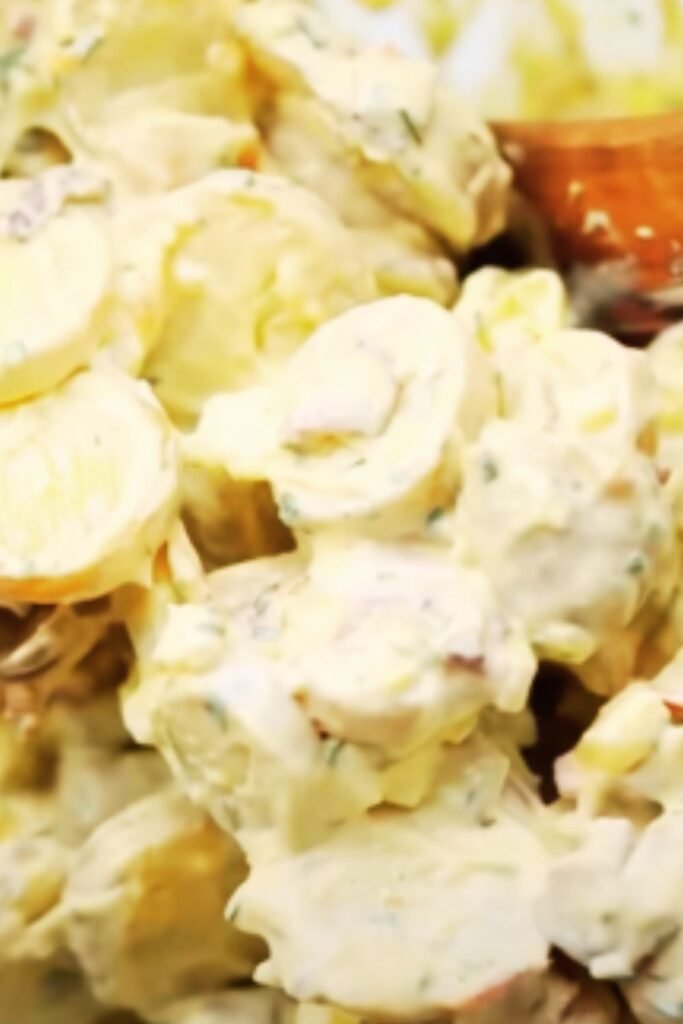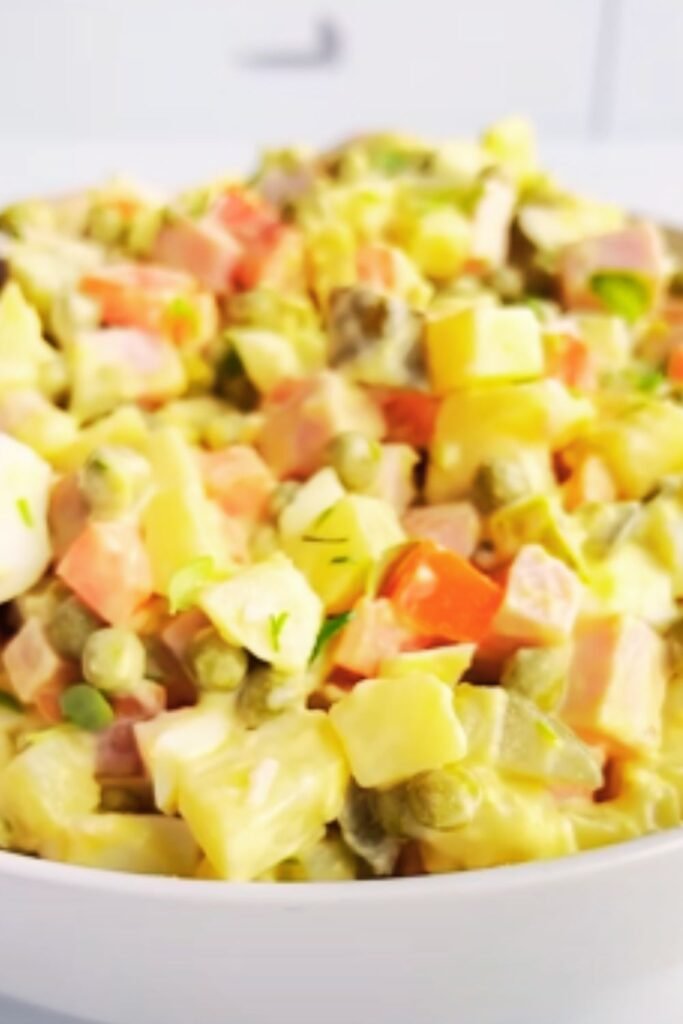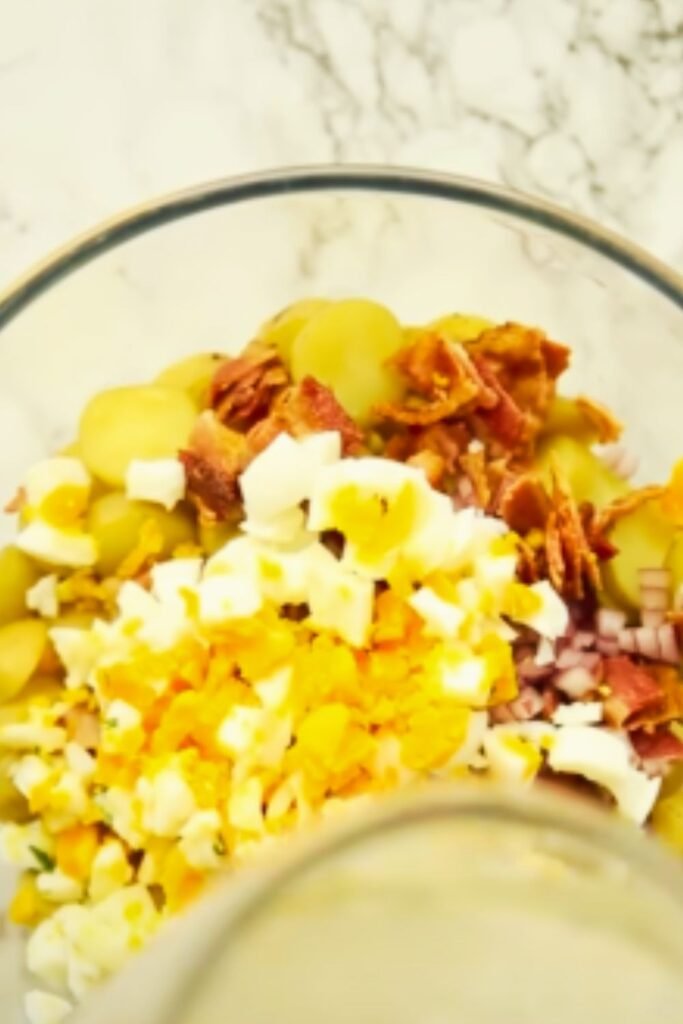There’s something deeply comforting about a well-made potato salad. That perfect balance of creamy, tangy dressing coating tender chunks of potato, punctuated by crunchy bits of celery and the sharp bite of onion. I’ve spent years perfecting my recipe, and today I’m sharing every secret I’ve discovered along the way to create what I confidently call the best potato salad you’ll ever taste.
Growing up in a family where summer gatherings were incomplete without a giant bowl of potato salad, I’ve had plenty of opportunities to experiment. I’ve learned that the perfect potato salad isn’t just about ingredients—it’s about technique, timing, and understanding the science behind what makes potatoes behave the way they do.
Whether you’re planning a backyard barbecue, preparing for a potluck, or simply craving a comforting side dish, this comprehensive guide will help you create potato salad perfection. From choosing the right potatoes to innovative flavor variations, I’ve covered it all.
The Perfect Potato: Foundation of Excellence
The journey to exceptional potato salad begins with selecting the right potato. This decision affects everything from texture to how well the finished salad holds up over time.
Best Potatoes for Potato Salad
- Waxy potatoes (red potatoes, fingerlings, new potatoes): These hold their shape beautifully after cooking and don’t fall apart when mixed. Their firm texture creates distinct potato chunks in your salad.
- Medium-starch potatoes (Yukon Gold): My personal favorite for potato salad. They offer the perfect middle ground—creamy enough to absorb dressing but firm enough to maintain their shape.
- Starchy potatoes (Russets): While not traditionally used for potato salad, they can work if you prefer a softer, more broken-down texture where some of the potato integrates into the dressing.
I typically reach for Yukon Golds for their buttery flavor and ideal texture. Their thin skins also mean less peeling work, as they’re delicate enough to leave on without compromising the salad’s texture.
The Science of Perfect Potato Cooking
Properly cooking potatoes for salad is an art backed by science. Understanding what happens to potatoes during cooking will help you achieve consistent results.
Cold Start vs. Hot Start
I always begin with cold water rather than dropping potatoes into already-boiling water. Here’s why:
Starting potatoes in cold water allows them to heat gradually, cooking evenly from outside to center. Dropping potatoes into boiling water cooks the outside quickly while the center remains raw, often resulting in unevenly cooked potatoes with mushy exteriors and firm centers.
The Salt Factor
Adding salt to your cooking water isn’t just about flavor—it’s about science. When potatoes cook in salted water, the salt penetrates the potato, seasoning it throughout rather than just on the surface. I use 1 tablespoon of kosher salt per 4 cups of water as my standard ratio.
Testing for Doneness
The difference between perfectly cooked and overcooked potatoes can be just a minute or two. I test by inserting a fork or knife into the largest piece—it should slide in easily but still meet slight resistance. If it falls apart, you’ve gone too far.
The Ultimate Potato Salad Recipe
Now that we understand the foundations, let’s dive into creating the perfect potato salad.
Ingredients
For the potatoes:
- 3 pounds Yukon Gold potatoes, scrubbed clean
- 2 tablespoons kosher salt (for cooking water)
- 2 tablespoons apple cider vinegar
For the dressing:
- 1 cup mayonnaise (preferably homemade)
- 2 tablespoons Dijon mustard
- 2 tablespoons sweet pickle relish
- 1 tablespoon fresh lemon juice
- 1 teaspoon celery seed
- ½ teaspoon paprika
- Salt and freshly ground black pepper to taste
Mix-ins:
- 4 hard-boiled eggs, peeled and chopped
- 3 celery stalks, finely diced
- ½ red onion, finely diced
- 3 tablespoons fresh dill, chopped
- 2 tablespoons fresh parsley, chopped
- 2 tablespoons chives, thinly sliced
Step-by-Step Instructions
- Prepare the potatoes: Cut potatoes into 3/4-inch chunks. I prefer to leave the skins on for texture and nutrition, but you can peel them if you prefer. Maintaining consistent size is crucial for even cooking.
- Cook to perfection: Place potato chunks in a large pot and cover with cold water by about an inch. Add 2 tablespoons kosher salt. Bring to a gentle boil over medium-high heat, then reduce to a simmer. Cook until potatoes are just tender when pierced with a fork, about 12-15 minutes (timing will vary based on potato variety and chunk size).
- The secret step: Drain potatoes thoroughly in a colander, then immediately transfer them to a large bowl. While still hot, sprinkle with apple cider vinegar and gently toss. This step is magical—the warm potatoes absorb the vinegar, creating an internal layer of tangy flavor that ordinary potato salads lack.
- Rest and cool: Allow the vinegar-tossed potatoes to cool for about 30 minutes. They should be warm but not hot when you add the dressing.
- Prepare the dressing: While potatoes cool, whisk together mayonnaise, Dijon mustard, pickle relish, lemon juice, celery seed, and paprika in a bowl until smooth. Season with salt and pepper to taste.
- Combine everything: Add celery, red onion, eggs, and herbs to the potatoes. Pour about two-thirds of the dressing over the potato mixture and gently fold everything together. Add more dressing as needed until you reach your desired creaminess. Remember that the salad will absorb some dressing as it sits.
- The waiting game: Cover and refrigerate for at least 4 hours, but preferably overnight. This resting period allows flavors to meld and develop.
- Final touch: Before serving, taste and adjust seasoning if necessary. I often add a fresh sprinkle of herbs on top for color and a pop of flavor.

Troubleshooting Common Potato Salad Problems
Even experienced cooks sometimes encounter issues with potato salad. Here’s how to solve the most common problems:
Problem-Solution Guide
| Problem | Cause | Solution |
|---|---|---|
| Watery potato salad | Potatoes not drained properly or still hot when dressed | Drain potatoes thoroughly and allow them to cool before adding mayonnaise-based dressing |
| Bland flavor | Insufficient seasoning or not enough resting time | Season the cooking water generously; add vinegar to warm potatoes; ensure adequate salt in dressing; allow salad to rest before serving |
| Mushy potatoes | Overcooked potatoes or excessive stirring | Cook potatoes just until tender; fold ingredients gently rather than stirring vigorously |
| Dry texture | Too little dressing or potatoes absorbed all moisture | Reserve some dressing to add just before serving if salad seems dry after chilling |
| Discolored potatoes | Exposure to air too long before dressing | Toss warm potatoes with vinegar immediately after draining; ensure potatoes are fully coated with dressing |
Variations To Keep Things Interesting
While my classic recipe is a crowd-pleaser, I love experimenting with different flavor profiles. Here are some of my favorite variations:
Herb Garden Potato Salad
Replace the classic mix-ins with an abundance of fresh herbs—think tarragon, basil, chives, dill, and parsley. Use a lighter dressing with more lemon juice and less mayonnaise for a fresher taste.
Mediterranean-Inspired
Skip the mayonnaise entirely and dress your potatoes with good olive oil, lemon juice, and Dijon mustard. Add sun-dried tomatoes, Kalamata olives, artichoke hearts, and crumbled feta cheese.
Loaded Baked Potato Salad
Transform your potato salad by incorporating baked potato toppings: crispy bacon, sharp cheddar cheese, sour cream in the dressing, and sliced green onions. Serve warm for an incredible twist.
German-Style
Create a warm potato salad with a vinegar and mustard dressing, bacon, and sliced onions. This tangier version pairs wonderfully with grilled sausages and hearty mains.
Curried Potato Salad
Add curry powder, turmeric, and a touch of honey to your dressing. Mix in golden raisins, diced apple, and toasted almonds for a sweet-savory combination that’s unexpected and delicious.

Make-Ahead and Storage Tips
Potato salad isn’t just convenient for feeding crowds—it actually improves with time as flavors meld. Here’s how to maximize its potential:
Optimal Timeline
- 1-2 days before serving: Prepare and cook potatoes; make dressing separately.
- Day before serving: Combine potatoes with dressing and most mix-ins (reserve some herbs for garnishing later).
- 4-6 hours before serving: Remove from refrigerator, adjust seasoning and moisture, add fresh herbs.
Storage Guidelines
- Refrigeration: Always keep potato salad cold. Store in airtight containers in the coldest part of your refrigerator.
- Safety: Never leave potato salad at room temperature for more than 2 hours (1 hour if the ambient temperature is above 90°F/32°C).
- Shelf life: Properly stored potato salad will keep for 3-5 days in the refrigerator.
Serving Suggestions
The versatility of potato salad makes it an excellent companion to numerous main dishes. Here are my favorite pairings:
- Classic backyard barbecue: Serve alongside grilled burgers, hot dogs, or chicken
- Southern feast: Pairs wonderfully with fried chicken, collard greens, and cornbread
- Picnic spread: Complement with sandwiches, fresh fruit, and crunchy vegetables
- Holiday meal: Works beautifully with ham, roast turkey, or prime rib
- Seafood dinner: Lighter versions go well with grilled fish or seafood boils
For an elegant presentation, serve in a glass bowl to show off the layers of ingredients, or portion individual servings in small mason jars for a picnic.
Nutrition and Dietary Adaptations
Traditional potato salad isn’t known for being particularly light, but there are ways to adapt it for various dietary needs without sacrificing flavor:
Healthier Alternatives
| Traditional Ingredient | Lighter Alternative | Benefit |
|---|---|---|
| Full-fat mayonnaise | Greek yogurt or mixture of yogurt and light mayo | Reduces calories and fat while adding protein |
| Salt | Fresh herbs and lemon zest | Enhances flavor while reducing sodium |
| Egg yolks | Extra egg whites or fewer whole eggs | Reduces cholesterol and fat |
| Pickle relish (often high in sugar) | Fresh diced cucumber with herbs | Decreases sugar and adds crisp texture |
| Heavy dressing coating | Lighter dressing with some olive oil | Improves nutritional profile while maintaining moisture |
Dietary Modifications
- Vegan: Use vegan mayonnaise, skip the eggs, and add extra vegetables for texture
- Gluten-free: Traditional potato salad is naturally gluten-free (just verify your mustard and mayonnaise brands)
- Low-carb: Replace half the potatoes with cauliflower florets that have been briefly blanched
- Paleo/Whole30: Use homemade avocado oil mayonnaise and omit sugar-containing ingredients like pickle relish

Q&A: Potato Salad Mysteries Solved
Over the years, I’ve been asked countless questions about making the perfect potato salad. Here are answers to the most common queries:
Q: Why do my potatoes always break down and turn mushy? This usually happens for one of three reasons: using too starchy a potato variety, overcooking the potatoes, or mixing too vigorously. Try using waxy potatoes like Yukon Golds, being vigilant about cooking time, and folding ingredients gently rather than stirring.
Q: Is it better to dress potatoes while warm or cold? I recommend a two-step approach: Add vinegar to potatoes while still warm (they’ll absorb more flavor this way), but wait until they’ve cooled to add mayonnaise-based dressing (adding it to hot potatoes can cause the mayonnaise to break).
Q: Can I make potato salad a day ahead? Absolutely! In fact, I recommend it. The flavors develop wonderfully overnight. Just hold back some fresh herbs to add right before serving for brightness.
Q: Why does my potato salad taste bland even though I’ve added plenty of salt? The potatoes themselves need to be seasoned during cooking. Always salt your cooking water generously—it should taste like sea water. Also, cold dishes need more seasoning than hot ones, as cold temperatures dull flavor perception.
Q: My potato salad becomes dry in the refrigerator. How can I prevent this? Potatoes continue to absorb moisture even after cooking. Reserve some dressing to stir in just before serving, or add a splash of pickle juice or a dollop of sour cream to refresh it.
Q: How long can potato salad sit out at a picnic? For food safety, don’t leave potato salad at room temperature for more than 2 hours, or 1 hour if the temperature is above 90°F (32°C). For outdoor gatherings, place your serving bowl in a larger bowl filled with ice to keep it chilled.
Final Thoughts
A truly exceptional potato salad is more than just a side dish—it’s often the first empty bowl at any gathering. The beauty of potato salad lies in its versatility and how it welcomes personalization. The recipe I’ve shared is my gold standard, but I encourage you to adapt it based on your tastes and traditions.
Remember that great potato salad comes down to attention to detail: properly cooked potatoes, seasoning in layers, a thoughtfully prepared dressing, and time for flavors to develop. Master these elements, and you’ll never need to buy store-bought potato salad again.
Whether you’re making it for a holiday feast, summer cookout, or simply as a comforting side dish for a family dinner, this potato salad recipe delivers consistent satisfaction. I hope it becomes a treasured recipe in your collection, just as it has in mine.
What makes this potato salad “the best” isn’t just its ingredients or technique—it’s the care and intention behind its preparation. Food made with love simply tastes better, and this potato salad has been crafted with decades of love and experience.


